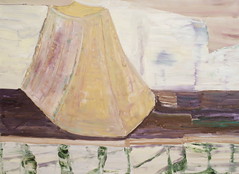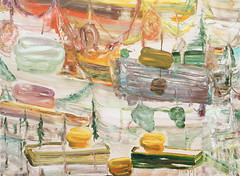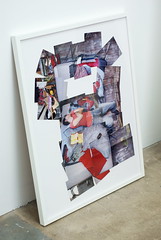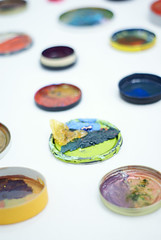Peter Otto's putrid palette befits his ghoulish subjects: he is a painter of the dead and the dying. Even so, "gore" per se isn't wholly descriptive Otto's preoccupation. In formal contrast to the documentation produced by photojournalists working in the theater of war, Otto consciously employs "painterly" abstraction. Through said means he's able to communicate in a nuanced manner, preventing both immediate fixation by horrific details and also too quick an interpretation thereof.

It's only slowly, while carefully examining the whole of Otto's most recent show, "The Lodger," that one is moved to consider what relationship might exist between a human skin stretched taut to form a lampshade and the fabric of a tent set in the desert. What does one membrane have to do with the other? Why establish such a parallel? Well, "cruelty and suffering," as enduring features of the human condition, might be one short answer. A better and longer exegesis would entail some discussion of the propensity of men to cause harm under cover of the name of that which they call "good."

Moving masses of people to believe that they've freely chosen to participate in national and international conflict usually depends upon the promulgation of some ideology. Being non-corporeal, that ideology must (where visual artists eschew the use of text) symbolically "incarnate" prior to being available to spectators. Emptied of their humanity, Otto’s lifeless subjects are placeholders for the bad ideas which led to their demise.

Metaphorically, "headhunting" is suggested by Otto to be the practice of savage warriors and effete politicians alike. For if some men do derive erotic gratification from the suffering of their fellows (we hope that) most do not. Most men need to be led to believe in the "rightness" of the cause for which they leave all that they love--only to fight and die in alien lands.
The (cyclical) tragedy depicted by Otto reaches back to the foundational works (if not also the symbols) of the Western canon, e.g., Thucydides' History of the Peloponnesian War. Seafaring, cosmopolitan, and commercial, Otto's own kinsman from the Netherlands might not be so distant from those Athenians of yore.

Whether particular knowledge of art and history is prerequisite to access the deeper levels of meaning available in Otto's paintings, the selection of works at Devening Projects is focused upon the time and space extending from Europe in the 1930s and 1940s to the present-day Middle East. Found most bluntly in the title, "Hand of History (Ode to John Heartfield)", is Otto's acknowledgment of Modern art historical precedent. Yet more incisive than said textual citation of Heartfield's name is the visual reference from the same piece, wherein Otto seems to wholly appropriate the central motif of Heartfield's 1934 montage, "O Christmas Tree in German Soil, How Crooked Are Your Branches."

In Heartfield/Herzfeld's oeuvre, symbols with otherwise positive connotations were as a matter of routine co-opted and re-made into Nazi emblems; Heartfield's "Christmas Tree" suffered a deformation of its limbs, producing a swastika. Otto appears to lift that tree-become-swastika, that equilateral cross with arms bent at right angles, only to set it once again in a human arm bent at a right angle. As goes the tree, so goes the man.
Neo-expressionist brushwork and color keep these paintings distant from Herzfeld's photomontage. But, the paintings hang tightly together in what's a remarkably cohesive presentation. In toto, it looks like a display of mature style--something which is now found only rarely outside of local museums. And it's a pleasure to encounter that maturity not only on the canvas but also in the artist himself. What hope Otto has to offer is found only there, outside and above the spaces depicted, in his own real, creative act. His verdict upon large-scale political solutions can be identified in the form of flags, not so much folded as deposited--coiled in snake or feces-like piles--upon the coffins of vainglorious corpses...

Peter Otto
"The Lodger"
March 7 - April 9, 2010
Devening Projects + Editions,
3039 West Carroll Avenue
Chicago, IL 60612
(312) 420-4720
http://deveningprojects.com
Support: Cultural Services in the USA / Consulate General of the Netherlands and Materiaalfonds, Amsterdam.
First draft, April 5, 2010, in Newcity,
http://art.newcity.com/2010/04/05/review-peter-ottodan-devening-projects-editions/
Images posted, with comments, March 8, 2010, at Sharkforum,
http://www.sharkforum.org/2010/03/peter-otto-devening-projects.html
Feed taken, March 8, 2010, ArtSlant New York,
http://www.artslant.com/ny/feeds/show/61816
Second draft, December 16, 2010, at this location.
See also: Peter Otto interviewed in Bad at Sports Episode 240,
http://badatsports.com/2010/episode-240-peter-otto/
- Paul Germanos







